- Home
- Encyclopedia
- Batiste Gamara, An Italian Immigrant Who Mined ...
Batiste Gamara, an Italian Immigrant who Mined Wyoming Coal
On Nov. 10, 1887, during the reign of Umberto I as the second king of the unified Italy, a farmer, Battista Gamarra, stepped into the town hall to register the birth of his first son by his wife Maria Notario. At that time, fancy names were not in fashion, and the new father didn’t think twice before calling his son with his own name, which was also the name of his father.
Another Battista Gamarra was born, the third we know of.
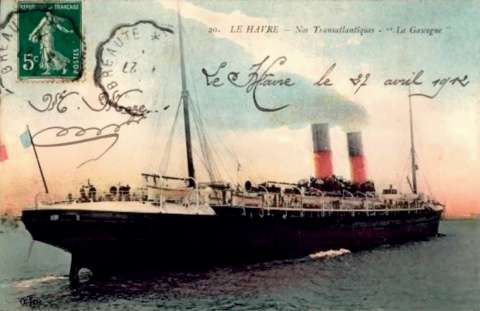
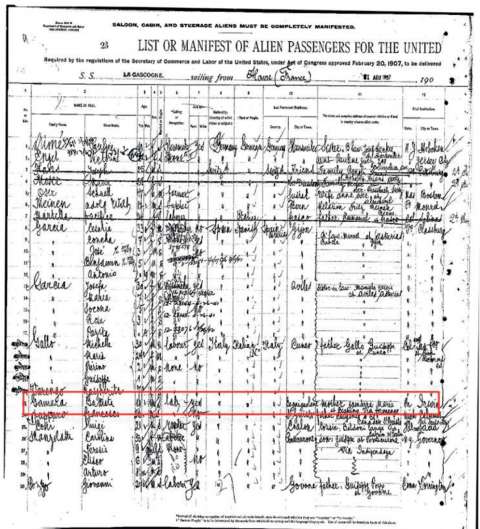
The 1881 census tells us that San Benigno Canavese—in the Piedmont region of northern Italy, 20 kilometers northeast of Turin—was a farming village of just over 3,000 people.
Village life
The splendor of the medieval history of the rich and powerful Fruttuaria Abbey was already a distant memory, and even the short distance from Turin did not seem to have any positive influence on the economy and on the inhabitants’ lives. Only the Salesian priests’ house, established in 1879, contributed to modernity. The priests gave attention to young people with modest carpentry, tailoring and blacksmithing courses, and later with evening schools and an oratory hall. Almost all the people of the time led the hard and arduous life of farmers: a plot of land, several cows, the mass and the pub on Sundays.
If a christening or a wedding party happened, they would enjoy a nice lunch with agnolotti pasta and fried or boiled meat, which the women had cooked all together, singing and exchanging gossip. Then, the country folk would break into a dance on the farmyard to the sound of the accordion.
In August, having some extra money in their pockets after the harvest, they celebrated the patron saint’s festival. On the feast day, there were stalls with candies for the kids and a dance pavilion; the girls would dress up and the young men would strut around in white shirts and vests, and with their hats pulled back.
Battista went to school for just long enough to learn how to read and write and do arithmetic. He grew up well and enjoyed good health, while the family expanded with the birth of his sisters Maria and Teresa in 1890 and 1895.
It was not easy for a farmer to maintain a five-member family. He could reasonably hope for a suitable marriage for his daughters, whereas the boy had only one prospect: to become a farmer like his father and his grandfather.
The life became even more difficult when, in 1898, the father Battista died at the age of 49. The three children were somehow raised by the widow with the help of her brothers and her two sisters, the younger Battista’s aunts.
The daughters’ lives took their expected courses. Maria married Battista Grua, a building contractor, and Teresa married Luigi Costa, who first was a coachman and then a farmer. They became mothers, then grandmothers and their lives spanned the late 19th century and the first half of the 20th.
The young Battista tried to be a farmer, but the stories of those who had crossed the ocean and gone to America reached even San Benigno. They told of big cities, of wide-open spaces and job opportunities. Illustrated leaflets were handed out, evoking dreams for a better future.
The emigrant
Battista began dreaming of leaving the small world of the village, taking a train and then a ship, and getting to New York, although it was hard for him to believe that there really existed buildings high enough to touch the sky. His dreams, his hopes and the difficulties of a hard life with no prospects of improvement were the same that drove more than 8 million Italians to emigrate between 1900 and 1915. More than 800,000 of them were from Piedmont.
Young people and whole families set off from San Benigno. This remote Italian village with a strange name appears several times in American immigration records. Sometimes its name is twisted into Begnino, Fan Beniguo or Benignolane, as the birthplace of others named Gamarra and then Bertorello, Bosco, Tapparo, etc.
It was not easy to decide to leave the family and the village that represented his whole world, but in the end Battista made up his mind. He scraped together the sum requested by the shipping company’s agent who saw to everything: the passport, the train ticket and the ship pass. Battista, this 19-year-old boy who had only traveled as far as the nearby villages of Volpiano and Bosconero, set off on a journey of which he had only heard tales.
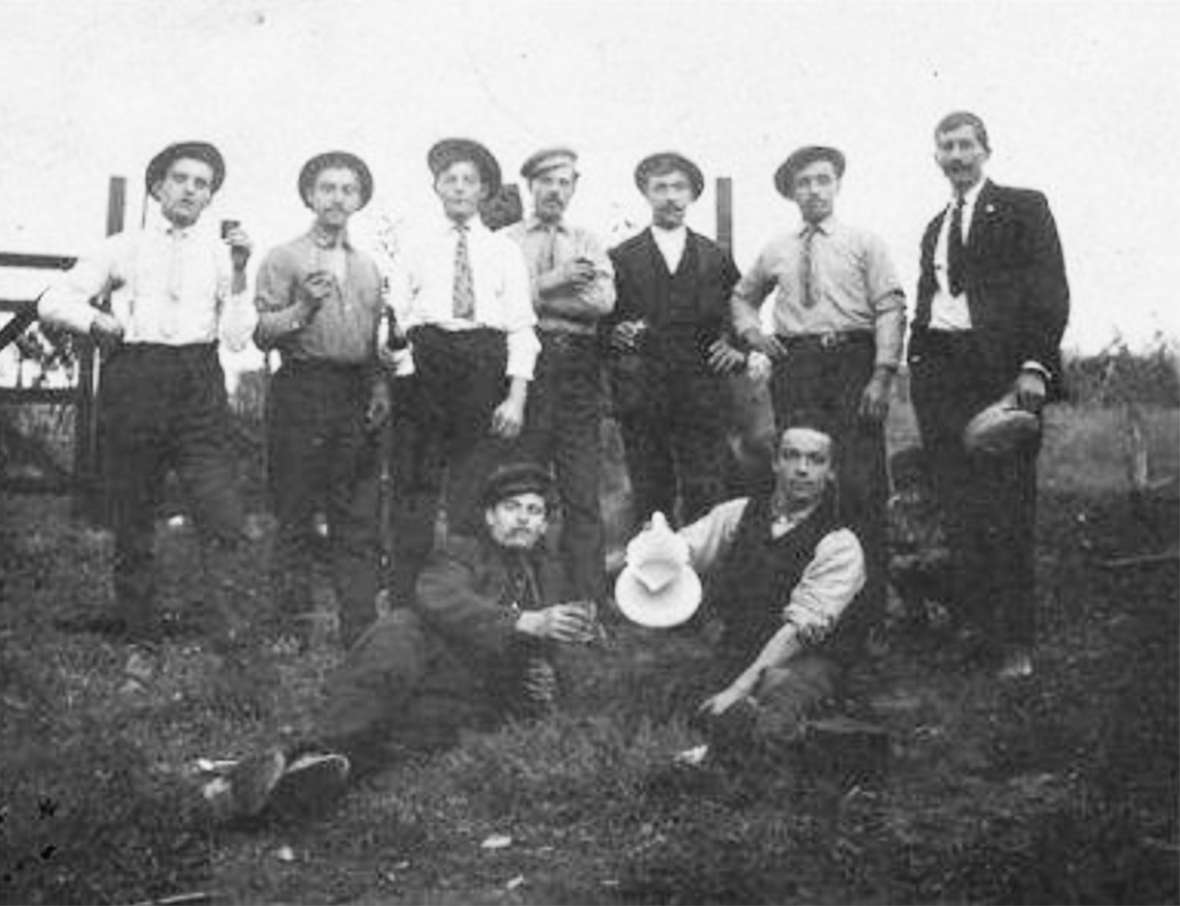
A sea voyage
He started from Le Havre, on the French coast of the English Channel, at the end of August 1907 on the ocean liner La Gascogne, a 150-meter ship traveling on the scheduled route from Le Havre to New York. The ship could carry 1,055 passengers: 390 in first class, 65 in second class and 600 in third class. Battista was certainly one of the latter with the other people from Piedmont, as well as Spain, Germany, and with many Turks, Greeks, etc.
The journey was not an easy one: The ship was overcrowded, the accommodations fairly Spartan, to say the least, but luckily the sea was quite calm, and the excitement and the enthusiasm of the youth helped overcome all problems.
Seeing the port of Le Havre, hearing so many different languages and dialects, Battista realized that the world was much bigger and more complicated than he imagined when he was daydreaming with his friends under the canopy of the market in the town square. But when he came to New York, he--like all the poor people from all over Europe--was really amazed. The harbor waters were crossed by a lot of boats, ferries, small boats and large barges carrying any kind of goods. He saw the biggest buildings he had ever seen, the tall skyscrapers; he saw the Brooklyn Bridge and the Statue of Liberty.
The new land seemed to live up to his expectations.
Like all immigrants, Battista too had to submit himself to immigration checks, which he sailed through.
The documents tell us that he arrived in New York on Sept. 9, 1907, at 19, claiming to have $30 in his pocket, to be a laborer by profession, to know how to read and write and to want to reach his cousin Giovanni Bertorello in Pennsylvania. According to the papers, he was 5 feet 4 inches tall (about 1.60 meters), had a dark complexion and auburn hair.
In the transcript, the surname lost an “r” and became Gamara.
Pennsylvania coal mines
Battista Gamara began his new life in America.
From Pennsylvania Station, he took a train to Pittsburgh for a nearly 400-mile trip. There, only a few miles divided him from Claridge, one of the most important mining communities of western Pennsylvania where a lot of miners resided, working in the tunnels, living in the houses and buying goods in shops owned by the mining companies.
He, too, became part of the classic American story of European immigrants in the early years of the 20thcentury: from Ellis Island to hard work in the mines with picks and shovels.
In Claridge, the first mine opened in 1880, the second in 1891 and other minor ones in the following years. The economy was booming and the Pittsburgh steel industry required large amounts of energy. And coal was there, around the corner; you only needed to extract it and upload it onto the Pennsylvania Railroad, and then many tons of it were transported by way of the Ohio River and the Mississippi all over the country.
Thousands of immigrants of all nationalities came to the United States, and for all the people the job was the same: down in the tunnels, digging in the dark in sweltering heat, covered with coal dust, exposed to the ever-looming risk of accidents, explosions and collapses.
Six days a week for ten hours a day; that would be cut down to eight hours only in 1912.
Battista didn’t feel dispirited. Like many others, he didn’t forget his country, and he thought that if he committed himself to saving some money, he would go back and settle down in Italy. It was difficult to start a family in America: The mining areas were full of young male workers whose social life was confined within ethnic groups that became, on the one hand, communities of solidarity, on the other, closed circles where no one from outside was let in.
Immigrants often sent pictures home showing that things were going right. Battista was not an exception. A year after his arrival, in November 1908, he sent two beautiful photos to his aunt Notario Nota who worked as a maid in Turin. In one, he looks serenely straight into the lens. He is wrapped up in a coat buttoned up to the neck, with his cap turned back-to-front. In the other, he is posing with a dog, a rifle and a cartridge belt on the waist, showing us two huge hares and a rabbit--game bag of a successful hunt. In the same period, he also sent home a photograph of himself in Pennsylvania with Italian relatives and friends.
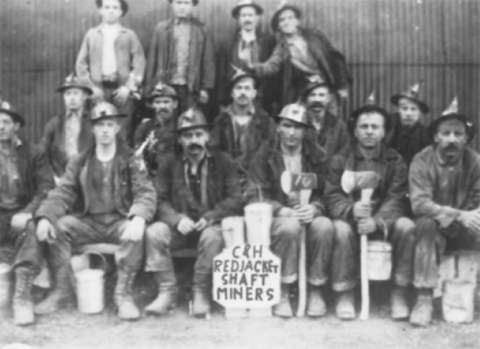
In January 1910 he sent two other photos to the same aunt. In both of them, Battista has a bottle in his hand. One shows him with a group of friends at a party, while in the other he is wearing a smart dark suit, a white tie and a pocket watch.
Michigan copper mines
Later, he decided to move to Calumet, on the shores of Lake Superior on the upper Michigan peninsula, having accepted the invitation of the relatives already settled down in Michigan. They had followed in the footsteps of Pietro Notario, who had arrived from San Benigno on the Canadian border in 1897. In another photograph, Battista is the first on the left in the front row along with his work mates. According to the sign, they are all miners working in the Red Jacket shaft of the Calumet & Hecla mining company, in those days the largest producer of copper all over the world.
If we look at the photo, turning the blind eye to the joker in the last row who’s making “bunny ears,” we can notice the workers are bursting with pride: it was a big thing working in a shaft that had been dug vertically through the rock to the copper lode. It was considered the deepest shaft in the world with its 1,500 meters under the surface.
The history of the copper district of Calumet is the history of the paternalism of a capitalist who built houses, schools and libraries but whose mines, at the moment a crisis in prices and the collapse of production in 1913, became the theatre of a big miners’ strike.
The conflict was very serious. Even the National Guard was called. There were clashes and tragic events: 73 people, of whom 59 were children, died at a Christmas party in the Italian Hall, crushed in a stampede because someone, still unknown, had given the false fire alarm.
Battista was certainly involved in the employment crisis caused by the sharp decline in output that dropped from 45,000 tons in previous years to 30,000 in 1912, and fell to 21,000 tons in the year of the strike.
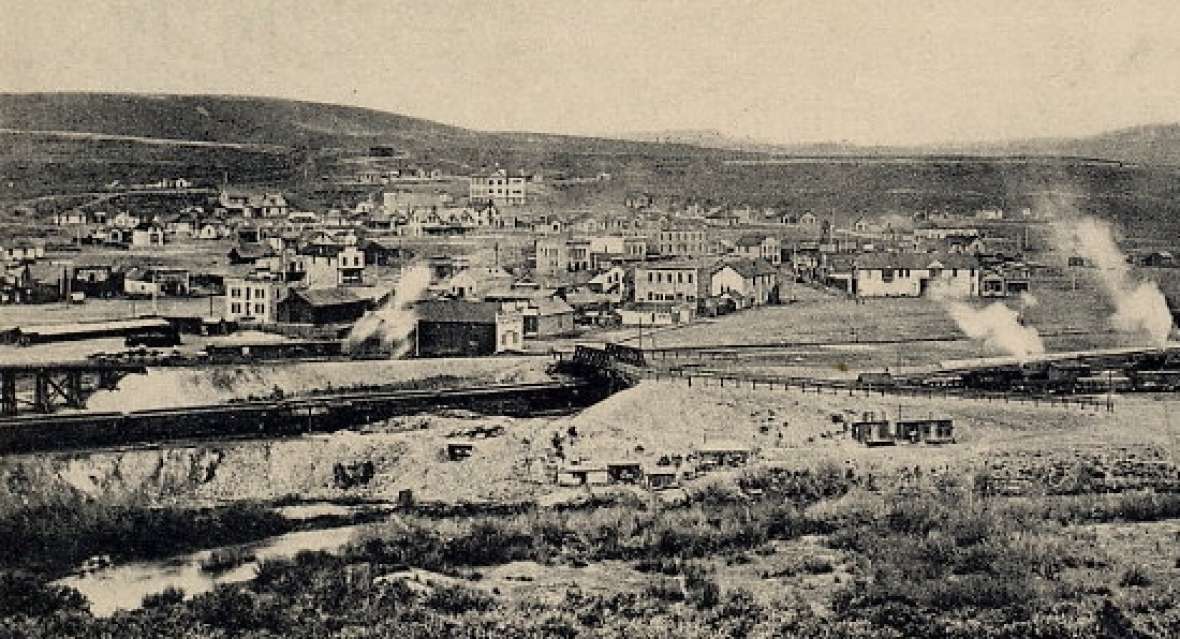
Coal again—in Kemmerer, Wyo.
Not being bound by family ties, he had no difficulty in changing places. Battista, some time later, moved farther west to Wyoming. There, large mining areas had been developed in the sparsely populated state, where until a few years before Crow, Arapaho and Shoshone tribes had roamed.
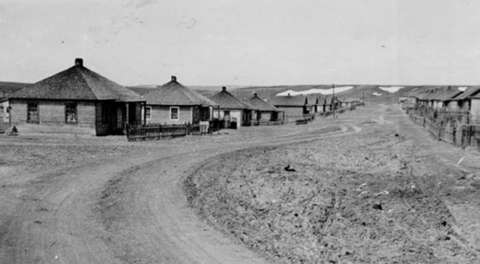
In a short time—seemingly out of nowhere—mining towns of Kemmerer, Cumberland and Sublet sprang to life. In the beginning, they were little more than encampments, and then gradually grew. The town that soon came to the forefront was Kemmerer. It became such an important mining city that in 1915, the local newspaper, the Kemmerer Camera, proudly flaunted this sentence as part of its masthead: “Kemmerer is the Railroad Center of the Largest Mining District of the West with a Payroll of $250,000.00 Monthly.”
Battista grew into a man and had already learned the ropes of his job. In order to integrate into the society, he enrolled in two fraternal organizations: Moose and Knights of Pythias.
In those days, the United States saw the rise of this kind of association, which had a social, charitable and benevolent purpose. The members stated that they believed in a supreme being, committed themselves to maintaining correct behavior, drinking moderately and not gambling. They met regularly to listen to edifying lectures, as well as for parties and celebrations and to discuss local issues.
Through these associations, Battista, commonly known as Batiste, became a valued member of the community and certainly began seeing tangible results of his efforts. In those years, the miners associated in a union and obtained wage improvements and better general employment conditions.
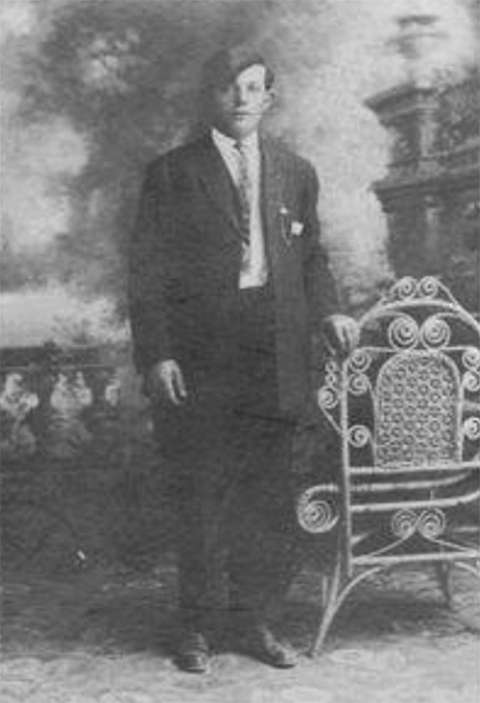
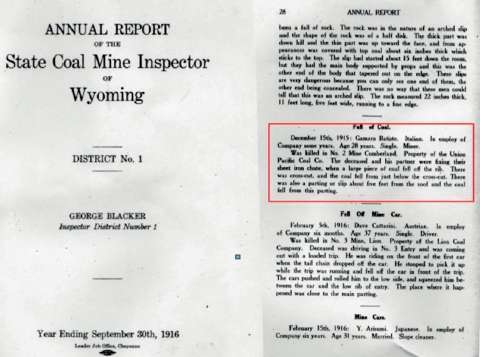
There are two professional pictures that certainly belong to that period: Battista had them taken at the Pohjola photograph studio in Kemmerer. In one of them he is with three friends; and in the other, with an important setting in the background, he is standing in a classic pose wearing a dark suit, his hand on the back of the chair. We can see that he is more robust and more mature, but always with the serene look of his clear eyes.
By Christmas 1915, Battista had been working in the American mines for eight years. The Kemmerer Cameraand the Kemmerer Gazettewere full of announcements of various celebrations and there was also a lot of diverse advertising: jewelry, toys, pans, corsets for the ladies and even special offers for the showers and the barber.
But fate decreed that Battista would not see that Christmas.
“Fall of Coal”
On Wednesday, December 15, he was working in the mine as usual, when, at 2:30 p.m. a big coal boulder suddenly fell from the ceiling of the gallery where he was digging and killed him instantly, while leaving his workmate unharmed.
There is an official report on the accident made by George Blacker, state inspector of the coal mines of Wyoming:
Fall of Coal.
December 15, 1915. Batiste Gamara. Italian. In the employ of company some years. Age 28. Miner. Was killed in the No. 2 Mine Cumberland. Property of the Union Pacific Coal Co.
Battista was an esteemed and appreciated man. The two lodges that he belonged to organized the funeral that took place, as always in these cases, on Sunday in order to allow the participation of co-workers.
On Sunday, Dec.19, 1915, at 10 a.m., a special train from Cumberland arrived in Kemmerer carrying the dead and colleagues.
His funeral, which the lodge brothers attended wearing black armbands, is described in the Kemmerer Cameraof December 22:
It was largely attended and the funeral procession was led by the band of Kemmerer, which played most appropriate music for the occasion. Gamara was 28 years of age and so far as known has no relatives in this country. He was held in the highest esteem wherever known and was a member of the Moose Lodge and the Knights of Pythias Lodge. The funeral occurring from the undertaking parlors, and interment being made in the Kemmerer cemetery. He carried some insurance in the orders he belonged to, and had saved up some money, but just what his estate amounted to is not known.
Once again, on Jan. 19 and 22, 1916, local newspapers published a notice from the Moose Lodge where members expressed condolences and the official appreciation for the services rendered by their brother Batiste.
We do not know how, but we certainly know that the news reached San Benigno, while Battista Gamarra, in American spelling Batiste Gamara, remained forever in Kemmerer.
His story is an emblematic story of many European immigrants who contributed with their work and their lives to build the industry and the economy of a great country such as the United States.
Today, more than a century later, his tombstone still stands in the Kemmerer cemetery, Lincoln County, Wyo. The care with which it is preserved is the moving evidence that the citizens of Kemmerer have not forgotten that their community was built by immigrants who arrived from all over the world.
Author’s Note:
We had only some pictures of this ancestor, and the only thing we knew is that he had died in the mines in the United States, place and date unknown. I wanted to learn more and, step by step, I managed to reconstruct the story of this forgotten young man who, like many others, sought his fortune by crossing the ocean in the early 20th century. I have written this booklet to pay my respect to the people the memory of whom has been virtually lost within a few generations.
I was amazed to discover how many people and how many families had set off from San Benigno to Pennsylvania, Michigan and Colorado facing the hardships and difficulties of a new world, adapting to the hard and dangerous mining work which, in Wyoming alone, caused on average 1,500 accidents a year. I wonder if one day someone will write their stories.
Heartfelt thanks to the Grua cousins and, especially to Maria Teresa, for their support, the research of the photographic documentation and the suggestions.
Special thanks to Nancy Anderson, a real expert in local history and the curator of the Hanna Basin Museum in Hanna, Wyo. With great courtesy, she provided me with information, tips and documents I needed for my research. I like to think of her as a friend from whom I’m divided only by a few thousand miles.
Resources
- “Fall of Earth Crushes Cumberland man.” Kemmerer Republican, Dec. 12, 1915, 4. Accessed April 10, 2018 via http://newspapers.wyo.gov.
- Kemmerer Camera, May 5, 1915, 1. Accessed March 6, 2018, at http://newspapers.wyo.gov.
- “Popular Miner Killed.”Kemmerer Camera, Dec. 22, 1915, 5. Accessed March 6, 2018, at http://newspapers.wyo.gov.
- “Resolution.” Kemmerer Camera, Jan. 19, 1916, 8. Accessed April 10, 2018 via http://newspapers.wyo.gov.
- “Resolutions.” Kemmerer Republican, Jan. 22, 1916, 6. Accessed April 10, 2018 via http://newspapers.wyo.gov.
- “S/S La Gascogne, C.G.T.” Norway-Heritage, accessed April 10, 2018 at http://www.norwayheritage.com/p_ship.asp?sh=lagae.
- Wyoming Tales and Trails. Pages on Cumberland, Wyo., and Kemmerer, Wyo., accessed April 10, 2018 at http://www.wyomingtalesandtrails.com/coalcumberland1.html and http://www.wyomingtalesandtrails.com/kemmerer.html.
Illustrations
- The photos of Cumberland and Kemmerer are from Wyoming Tales and Trails. Used with thanks.
- All other images are from the booklet Gamarra Battista di Battista fu Giovanni Battista, Una storia di emigrazione da San Benigno Canavese, published by the author, Sergio Vedovato, in 2016. His English translation of the booklet is the text of this article. Used with permission and thanks.
